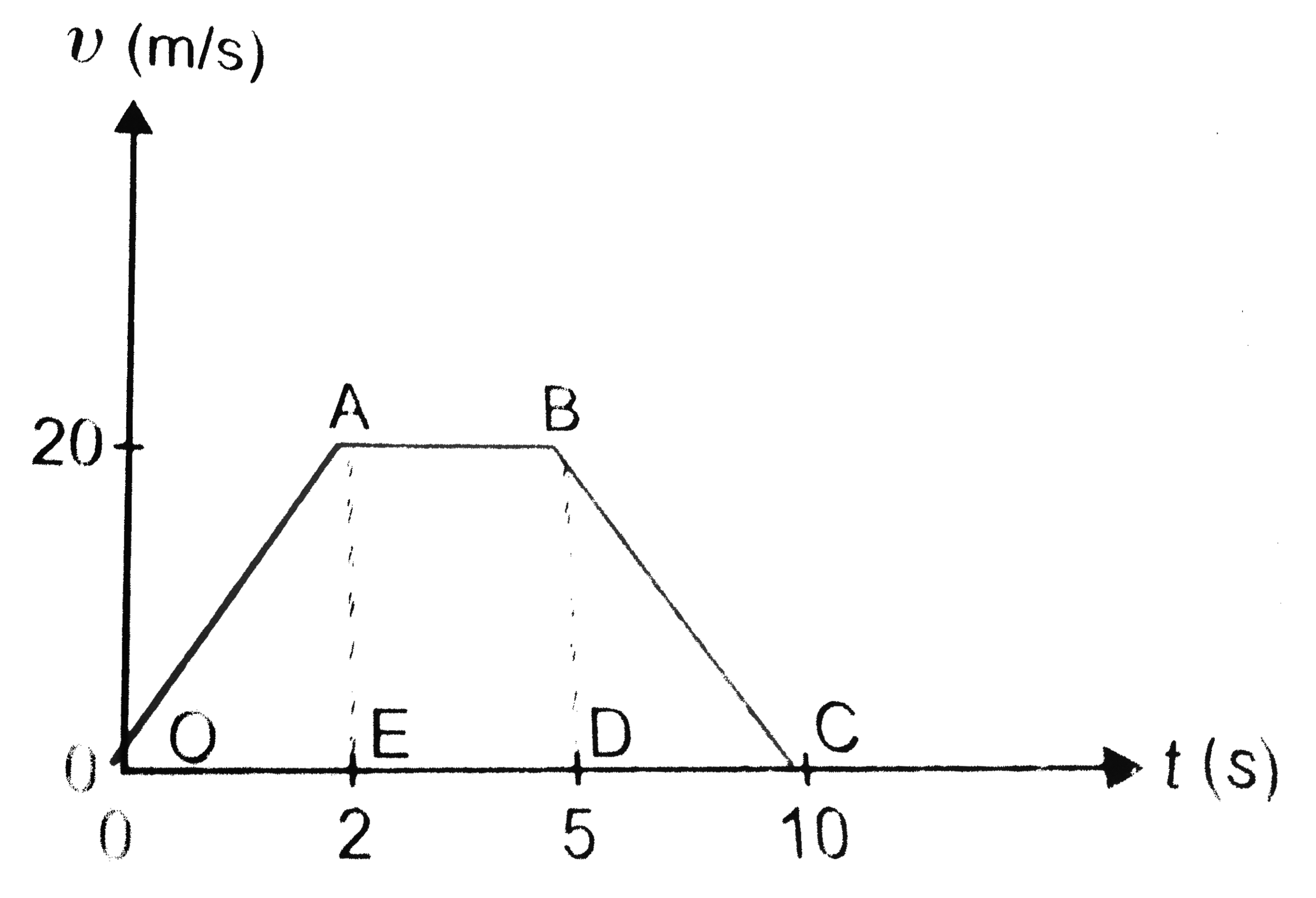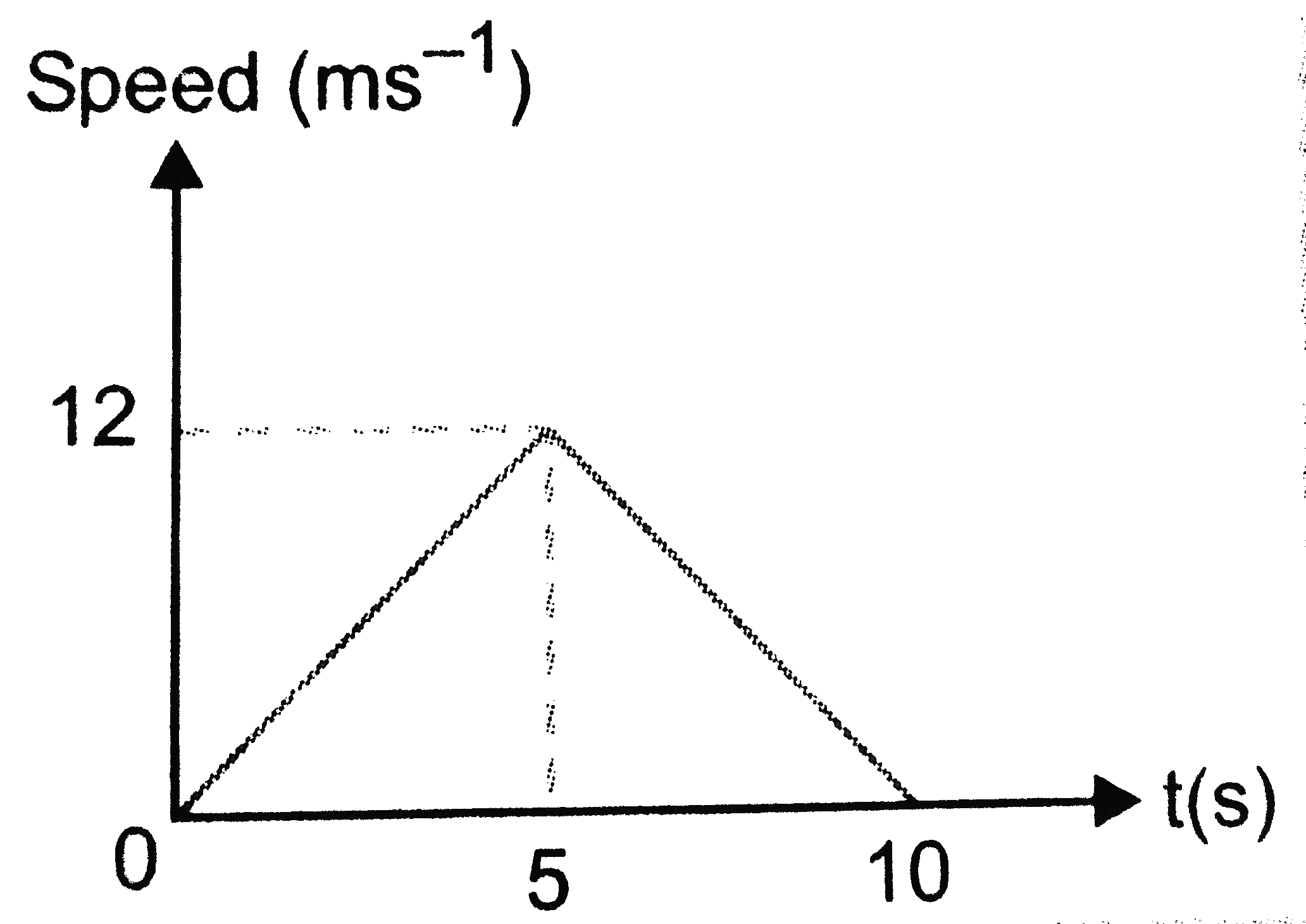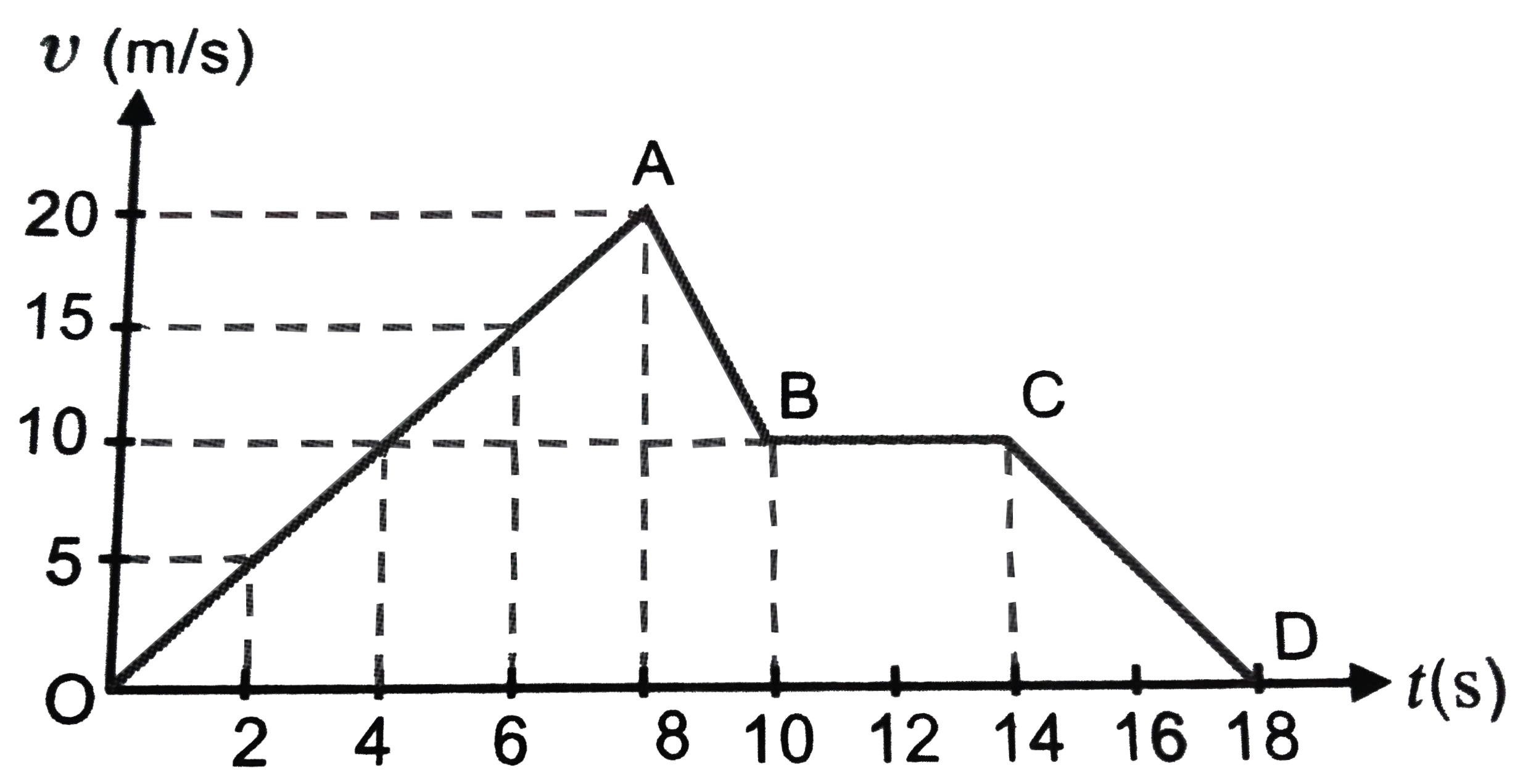Complete Solutions to 2 Problems for practice of chapter KINEMATICS of Class 11 book with complete answers and questions
| Class 11 | PHYSICS |
| Chapter | KINEMATICS |
| PRADEEP | 2 Problems for practice |
| Number Of Questions | 36 |
| Academic Year | 2023-24 |
On turning a corner, a motorist rushing at `44ms^(-1)` finds a child on the road `100 m` away. He applies the brakes so as to stop the motorcar within `1 m` of the child. Calculate the time required to stop.
04:51View SolutionA train moves with a constant speed of ` 36 km h^(-1)` in the first `10 minutes`, with another constant speed of ` 45km h^(-1)` in the bext ` 10 minnutes` and then with an acceleration of 5 ms^(-2)` in the last `10 minutes. Calculate the average speed of last ` 10 minutes`. Calculate the average speed of the train for this journey and the total distance travelled.
04:30View SolutionAn object is moving along+ve x-axis with a uniform acceleration of 4 ms^(-2)`. At time ` t=0`. X= 4 m` and ` v=2 ms^(-1)``.
(a) What will be the velocity and position of the object at time ` t=3 s?
(b) What will be the position of the object when it has a velocity ` 8 ms^(-1)` ?02:08View SolutionAn object is moving with a uniform acceleration. Its velocity after ` 5 s` 25 ms^(-1)` and after ` 8 s` is 34 ms^(-1)` Find the distance travelled by the object in ` 10 th second.
03:26View SolutionAn object is moving with uniform acceleration. Its velocity after ` 4s is 20 ms^(-1)` and after 7 second is 29 ms"^(-1)` . Find the distanc etravelled by the object in 10 th second.
03:40View SolutionA body covers `12 m` in ` 2nd` second and `20 m` in `4 th second` . Find what distansce the body will cover in ` 4 second` agter the ` 5 th second`.
05:09View SolutionAn object is moving along a straight line path with a uniform accleration of ` 4 ms^"(-2)`. Intitially its lociation is at ` 5 ms` and velcity is ` 3 ms^(-1)`. ltbRgt (i) What will be position and the velocity of object at time ` t=3 s?
(ii) What will be the position of the object when it has attained a velcotiy` 8 ms^(-1)` ?03:44View SolutionAn automobile starts from rest and accelerates unifomly for ` 30 second to a speed of ` 72 km h^(-1)`. It then moves with a uniform veocit and it is finally brought to rest in `50 m` with a constant retardation. If the total distance travelled is ` 950 m`, find the accleration, the retaradation and total time taken.
06:16View SolutionTwo diamonds begin a free fall from rest from the same height, 1.0 s apart. How long after the first diamond begins to fall will the two diamonds be 10 m apart? Take `g = 10 m//s^2.`
04:28View SolutionA stone is dropped from the top if a cliff and is found to travel ` 44. 1m` in the last second before it reaches the ground . Fing the height of the cliff.
01:58View SolutionA ball thrown up is caught by the thrower after ` 4 second`. How high did it go and with what velocity was it thrown ? How far below its highest point was in ` 3 second ` after starts ? Acceleration due to gravity is ` 9.8 ms^(-2)`.
03:11View SolutionFrom the top to a tower ` 100 m` in height a ball is dropped and at the same instant another ball is projeced veticall y upwards from the ground so that it just reaches the top of tower. At what height do the two balls pass one another ?
05:02View SolutionA bodu starting from rest, was onserved to cover ` 20 m ` in ` 1 secnd ` and 1 40 m` during the next second. How far had it travelled before the first observation was taken ?
04:01View SolutionA body is in motion along a strainght line. As it crosses a fixed point a stop watch is started . The body travels a distance of ` 1.80 m` . In the first 3 second and 2.20 m in next 5 seconds. What will be the velocity at the end of 9 second ?
05:28View SolutionA ball is dropped from the roof of a tower of height (h). The total distanc coverd by it in the last second of its motion is equal to the distance covered by in first three seconds. What will be the velocity at the end of `9 secind ` ?
03:41View SolutionA balloon rising vertically up with unitrom velcity ` 15 ms^(-1)` releases a ball at a deight of ` 100 m`. Calculate the time taken by the ball to hit the ground and total height of balloon when ball hits the ground. Take ` g= 10 md^(-2)`.
03:21View SolutionA stone is dropped from a balloon at an altitude of ` 300 m`. How ling will the stone take to reach the ground of (a) the balloon is ascending with a velocity of ` 5 ,s^(-1). (b) the ballon is descending with a velocity of ` 5 ms^(-1)` (c ) the balloon is shationary ?
05:06View SolutionA food packet is released from a helicopter which is trising steadily at ` 3 ms^(-1)`. After ` 3 seconds`, (i) what is the velocity of the packet? (ii) how far is it below the helicopter ? Take ` g= 9.8 m//s^2`.
02:36View SolutionThe velocity (u)-time (t) graph of an object moving alon a straight line is as shown is Fig. 2 (b) . 30. Calculate the distance covered by object between ` (i) t =0 to t=5 s` (ii) ` t=0 to t=10 s`.
 .02:32View Solution
.02:32View SolutionThe speed -time graph of a particle moving along a fixed direction id shown ifn Fig. 2 (b) . 31. Fid (i) distance travelled by the particle between ` 0 sec` to ` 10 sec` (ii) average speed between thid interval (iii) the time when the speed was minimum (iv) the time when the speed was maximum.
 .02:50View Solution
.02:50View SolutionThe velocit-time graph of a body moving in a straight line is shown in Fig. 2 (d) . 32. Find the displacement and the distance travelled by the body in ` 6 seconds`.
 .02:37View Solution
.02:37View SolutionThe velocity-time graph of a particle moving along a straight line is shown id Fig. 2 (b) . 33. Calculate the distance covered between ` t= 0 ` to `t= 10 seconds`. Also find displacement tn time ` 0 to 10 seconds`.
 .02:37View Solution
.02:37View SolutionThe velocity-tiem graph of a particle movitgn along a straight line is shown in the Fig. 2 ( b) . 34`be curve ` OABCD`. Calculate the distance covered by the particle between (i) ` t =zero to ` t=18 seconds (ii) t= 2 s to t= 12 s`. And the maximum value of acceleration during this interval.
 .03:48View Solution
.03:48View SolutionA car accelerates from rest at a constant rate ` alpha ` for some time after which it decelerates at a constant rate ` beta` to come to rest. If the total time lapse is ` t` seconds , evauate.
(i) maximum velocity reached , and
(ii) the total distance travelled .03:12View SolutionA car accelerates from rest at acionstant rate ` 36 km h^@` to comet to rest. If the total time elapsed id ` 1 hour, calculate (i) the maximum velocity attained by the car and (ii) the total distance travelled by car.
06:10View SolutionThe acceleration a in `ms^-2` of a particle is given by `a=3t^2+2t+2`, where t is the time. If the particle starts out with a velocity `v=2ms^-1` at `t=0`, then find the velocity at the end of `2s`.
02:57View SolutionThe height `y` and the distance `x` along the horizontal plane of a projectile on a certain planet (with no surrounding atmosphere) are given by `y = (8t - 5t^2) m` and `x = 6tm`, where `t` is in seconds. The velocity with which the projectile is projected at `t = 0` is.
02:46View SolutionA particle moves along a staight line such that its displacement at any time t is given by `s=t^3-6t^2+3t+4m`. Find the velocity when the acceleration is 0.
03:00View SolutionThe dispkacement of particle is zero at ` t= 0` and it is ` x` , at ` t-t`. It starts moving in the positive x-direction with a velocity which varices as ` v= k sqrt x`, where (k) is a constant. Show that velocity is directly proprtional to time.
02:36View SolutionThe relation between time `t` and distance `x` is `t = ax^(2)+ bx` where `a and `b` are constants. The acceleration is
02:33View SolutionThe ball is dropped from a bridge ` 122.5 m` above a rivet, After the ball has been falling for 2 s, a second ball is thrown straight down after it. What must its initial velocity be so that bothe hit the warer at the same time ?
02:40View SolutionThe acceleration a in `ms^-2` of a particle is given by `a=3t^2+2t+2`, where t is the time. If the particle starts out with a velocity `v=2ms^-1` at `t=0`, then find the velocity at the end of `2s`.
02:57View SolutionA ball is dropped from the top of a tower of height (h). It covers a distance of `h`/`2` in the last second of its motion. How long does the ball remain in air?
01:53View SolutionAn othleter runs a sidtance of ` 1500 m` as follows , (i) He starts from rest and accelerates himself uniformly with acceleration ` 2 ms^(-2)` till he covers a distance or ` 900 m`. (ii) He then runs the remaining distance of `600 m` with a uniform speed developed. Calculate the time taken by the athlete to cover the two parts to the distance central point of the total length of track.
04:35View SolutionA ` ` 100 m` sprinter in creases her speed from rest uniformly at the rate of ` 1. 5 ms^(-2)` up to three quarters of the total run and covers the last quarter with uniform speed. How much time does she take to cover the first half and the second half of the run ?
06:11View SolutionA jugglar maintains four balls in motion, vaking each in turn rise to a height of `20 .0 m` from his hand .Find the velocity with which the jugglar project these balls and the position of other three balls at the instant when the foruth ball is just leaving the hand of jugglar. Take `g= 10 m//s^2.
04:08View Solution
2 Problems for practice questions and complete solutions for chapter KINEMATICS of PRADEEP PHYSICS (HINGLISH) of Class 11
All Exercises from PRADEEP Class 11 PHYSICS KINEMATICS
- 1 Problems for practice
- 1 Con ceptual Problems
- 1 Conceptual Problems
- 1 Fill in the blanks
- 1 Long answer
- 1 Multiple choice
- 1 NCERT Assertion-Reaseon Type
- 1 NCERT Comprehension
- 1 NCERT multiple
- 1 Short answer
- 1 SolvedExamples
- 1 Very short
- 2 Con ceptual Problems
- 2 Fill in the blanks
- 2 Long answer
- 2 Multiple choice
- 2 NCERT multiple
- 2 Problems for practice
- 2 Short answer
- 2 SolvedExamples
- 2 Very short
- 3 Con ceptual Problems
- 3 Fill in the blanks
- 3 Long answer
- 3 Multiple choice
- 3 NCERT multiple
- 3 Problems for practice
- 3 Short answer
- 3 SolvedExamples
- 3 Very short
- 4 Con ceptual Problems
- 4 Conceptual Problems
- 4 Fill in the blanks
- 4 Long answer
- 4 Multiple choice
- 4 NCERT Integer type
- 4 NCERT multiple Choice
- 4 Problems for practice
- 4 Short answer
- 4 SolvedExamples
- 4 Very short
- 5 Long answer (NCERT)
- 5 Short answer
- 5 Very short
- 6 Long answer (NCERT)
- 6 Short answer
- 6 Very short
- Additional Exercises
- Advanced Problems
- Higher order thinking skills
- Motion
- NCRT Exercises
- Sample Promlem
- Value based
